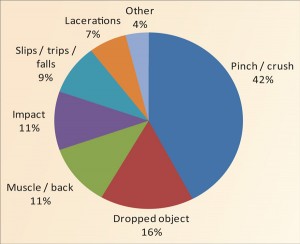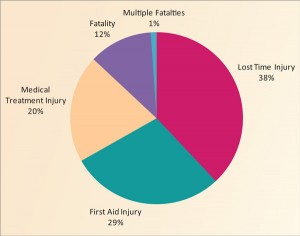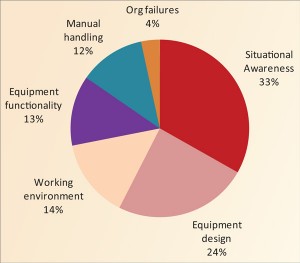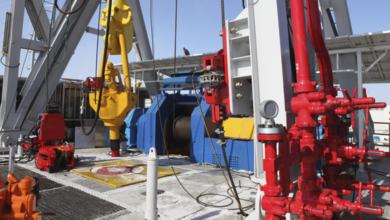Operator takes proactive approach to human-factors evaluation of equipment
By Sam Ranasinghe and Vikki Sanders, Atkins

Safety within the Gulf of Mexico (GOM) oil and gas industry has become the focus of attention around the world after the Macondo incident in April 2010. However, preceding this incident, safety had already been a priority throughout the industry. Industry safety statistics show that the recordable and lost-time incidents in US waters have been trending lower slightly but consistently over the past five years.Total recordable incidence rates for US offshore workers improved 7% between 2007 and 2008(IADC 2008).
°The focus on safety had multiple drivers: regulatory; financial, including insurance premium reduction and the cost of lost time; and corporate responsibility, which highlights the importance of employee well-being. Recent drivers include the now-mandated API RP 75, which applies to all offshore operations in US federal waters. This legislation requires more proactive focus on hazard management in operations with a more proactive approach to be taken.
One major oil and gas operator company recognized that their recordable incidents in the GOM primarily involved third-party contractors and their equipment. To reduce these incidents, the company initiated a proactive multidisciplinary safety program involving personnel from human factors (HF); health, safety and environment (HSE); engineering and operations from within their own personnel and third-party contractors.
The program involved thorough assessments of all drilling and completions equipment across the vendor supply chain with the aim of identifying and eliminating hazards to personnel. Initially, finger and hand pinch points were the focus, but the scope quickly expanded to include any hazard and potential safety issue.
A detailed approach used a task-based hazard identification (HAZID) process where input from operations personnel was integral to the process. This ensured that the issues raised were relevant and pertinent to the equipment operators and that the interaction between the operator and equipment remained in focus. This process complemented other HSE initiatives, such as offshore “hazard hunts” and job risk assessments. However, this systematic approach identified many equipment and procedural hazards that were not raised previously.
Approximately 40 HAZIDs were conducted with 25 vendors across the GOM supply chain. The equipment assessed ranged from complex machinery, such as casing tongs and bucking machines, to simple equipment, such as transportation baskets and pipe wrenches. Engaging with vendors across the supply chain demonstrated the operator company’s commitment to offshore safety and safety leadership. In light of the initiative’s success in the GOM, the company has extended the program to other locations around the world.
This article discusses the methodology used for conducting this program, as well as the major findings of the task-based equipment assessment and analysis.
Methodology
A systematic task-based approach was used. A task analysis was undertaken to gain an overview of the equipment being analyzed and to increase understanding of the key steps involved, particularly those tasks that are “hands-on” and carried out most frequently. This task analysis encompassed all aspects of equipment use, including:
- Transportation to the rig;
- Rig up;
- Operations;
- Rig down;
- Maintenance;
- Storage.
This task analysis was deliberately kept to a high level so the focus remained on the key tasks being analyzed. Task information was collated prior to each HAZID with input from the vendor and operator company engineers. This early engagement with the vendor ensured they clearly understood the objectives of the HAZID and obtained their commitment to the process from the start.
Each of the HAZIDs was conducted at the vendor site. They were facilitated by HF engineers and involved a multidisciplinary team with representation from HSE, engineering and operations personnel who were familiar with the equipment. Input from operations staff was vital to each HAZID. This provided the team with the necessary operational understanding of equipment use that may have been missing during earlier engineering design activities. Having floorhands present in the HAZID allowed them to explain in detail how the equipment is used in reality rather than what may be described in procedures.
During the HAZID, the previously prepared task analysis was used as a template for discussion and as a tool to ensure the attendees considered the different tasks involved with the equipment and where potential hazards might occur. As the HAZID was conducted at the vendor site, the equipment was available to be examined. It also provided an opportunity for the equipment operators to show how the equipment would be loaded out from the shop, how it is used in practice and where the potential hazards would lie.
During each HAZID, a bespoke guidewords list was used to stimulate discussion and to ensure that a wide range of hazards – from dropped objects and finger pinches through to chemical and ergonomic risks – were considered. To ensure more emphasis was placed on HF issues, more HF-related guidewords were used (e.g., reach, access/egress, controls, displays) compared with conventional HAZID guidewords lists.

When a hazard was identified, it was risk-ranked in line with the operator company’s risk-ranking matrix. Hazards were recorded and risk-ranked based on the severity of the consequence and likelihood of occurrence. The risk-ranking color determined the classification of the hazard, which then supported the discussion and decision-making on whether extra mitigations needed to be applied for the identified hazard. The higher the risk-ranking number, the more severe the risk was deemed.
Mitigations to hazards were discussed within the team and were recorded as recommendations. Ideally, these recommendations would eliminate the hazards, as this was the preference of the operator and was in line with their hierarchy of controls for hazards. The mitigations ideally would rely less on the human being; therefore, safeguards such as procedural changes and PPE were seen as the last line of defense and least effective.
The discussion of proposed recommendations was thorough and required agreement from both the operator company and the vendor. Each recommendation was carefully made so it was pragmatic and practical and did not introduce new hazards into the operation. Many recommendations were proposed during discussions but were subsequently discarded as it was felt that the recommendations would overcomplicate the process and lead to extra hazards with the operation. Having a collaborative approach in proposing recommendations helped to ensure that the vendor was committed to follow through and implement them.
Results
Hazards
In total, from the 40 HAZIDs conducted, 647 hazards were identified, with 635 recommendations made.
Given the variety of equipment, numerous types of hazards were identified. They varied from those that could cause a first-aid injury to those that could cause multiple fatalities. After analyzing the data, it could be seen that most hazards could be grouped under dedicated categories as similar hazard types recurred in the assessments. To better structure the analysis, the hazards were rationalized under seven key categories:
- Pinch/crush.
- Muscle/back strain.
- Lacerations.
- Slips/trips/falls.
- Dropped object.
- Impact.
- Other.
The data were independently judged and rationalized into categories. These were subsequently assessed by other study team members to ensure integrity. The “pinch/crush” hazard category refers to hazards where fingers, feet or body could be pinched or crushed by equipment. Examples include pinch points due to a basket lid closing inadvertently or crush points due to moving equipment.

The “muscle/back strain” category primarily refers to manual handling-related hazards. The “lacerations” category refers to hazards where an equipment operator may be cut from handling or brushing past equipment. An example includes cuts from sharp edges on cotter pins. The “dropped object” category refers to hazards caused by dropped objects falling from equipment and hitting an operator. This type of hazard was particularly pertinent for mechanically lifted loads.
The “slips/trips/falls” category refers to situations where an operator may slip, trip or fall when using equipment, e.g., falling from a work platform or trip hazards from cables. The “impact” hazard category refers to where an operator could be hit or impacted by equipment, e.g., swinging loads or whipping hoses. The “other” hazard category refers to those hazards that had only a few occurrences and therefore did not warrant having a dedicated category, e.g., chemical or electrical exposure or burns.
Consequences
Each identified hazard was risk-ranked using the operator company’s risk-ranking matrix. The risk matrix was based on consequence and likelihood.
Figure 2 shows the percent breakdown for the consequence as defined by type of injury for the identified hazards.
Causes
The key causes for the hazards were determined. As the majority of hazards had more than one identified cause, the hazard causes were rationalized under key categories:
- Situational awareness;
- Organizational failures;
- Manual handling;
- Working environment;
- Equipment functionality;
- Equipment design.
These rationalized categories were also independently assessed by study team members to ensure reliability of category. The “situational awareness” category refers to causes where an equipment operator does not have full awareness or cognizance during an operation. Examples of causes include poor hand or body placement or poor communication between operators.
The “organizational failure” category refers to causes where organizational issues were identified as a contributing factor to the hazards. Examples include inadequate training, poor planning or not restricting access to an area. The “manual handling” category refers to causes that led to related muscle/back strain-related hazards. Examples include heavy loads, improper manual-handling technique or repetitive motion.
The “working environment” category refers to causes where the working environment contributes to the hazards. Examples include weather conditions, rig motion and poor housekeeping. The “equipment functionality” category refers to causes where the functionality of the equipment was identified in contributing to the hazard. Examples include over- pressuring of equipment and improper securing of equipment. The “equipment design” category refers to causes where the design of the equipment contributed to the hazards. Examples include improper marking/labeling and equipment failure. Figure 3 details the percent breakdown of identified hazard causes.
Value added
With 647 hazards identified and 635 recommendations made and with the vast majority of the recommendations closed out by the vendors, it can be seen that a great deal of value was added from conducting the HAZIDs. Many hazards, along with subsequent recommendations, were identified that had been missed in previous equipment design reviews. This proactive approach to hazard management where hazards are identified and mitigated before they occur has been beneficial. It is commendable to the operator company for driving this initiative and committing the resources to proactively address personnel safety within their operations.
Most of the hazards identified were ranked in the amber or green category, which were deemed to be low- to medium-risk. Mitigations were always recommended for those few occurrences where red risk hazards were identified. However, even for the low risk-ranked hazards, recommendations were generally made to make the equipment safer. The philosophy for the HAZIDS was to reduce the risk to as low as reasonably practicable irrespective of how low risk the hazards were deemed to be.
Human Factors approach
The task-based approach adopted was successful in identifying hazards; it was different to conventional HAZIDs as it emphasized the HF element in equipment design with a focus on the human system interaction.
Compiling a task analysis provided invaluable insight into the different tasks being conducted, e.g., whether a particular load was being lifted manually or by mechanical means, or how equipment is made up above the rotary. From conducting this preliminary screening of tasks, it could be determined where the potential hazards could lie. During the workshop, discussing the task breakdown ensured the operators considered the different steps involved in the operation.
This was particularly poignant for tasks that are undertaken frequently and when hands are laid on the equipment. The task-based approach helped to guide the HAZID analysis of the operation step by step. It was commented from various attendees at the HAZIDs that this level of detail had never been considered previously and was extremely useful.
A fresh perspective
Using HF engineers’ alternative perspective (“a fresh pair of eyes”) on the equipment was useful in identifying the hazards. The operators’ regular use of the equipment could lead to complacency and operators becoming immune to hazard identification or knowingly accepting them as part of their normal day-to-day operations.
The design of equipment and alternative methods of conducting operations were questioned during the HAZIDs. Therefore, analyzing operations and equipment from a fresh angle and challenging them to think outside the box yielded beneficial results.
Vendor appreciation
Vendors also appreciated the detailed approach of the HAZIDs and the collaborative effort with the operator company. The HAZIDs provided a forum for floorhands to raise previously ignored safety concerns as a formal avenue was provided for issues to be identified and resolved with commercial push from the operator company.
Many recommendations, particularly concerning handling and pinch points (e.g., loading tool boxes and baskets), also improved the safety of equipment in the shop. All of these factors ensured that recommendations were more likely to be implemented with minor pushback. In addition, many recommendations would be implemented across the whole vendor supply chain. This may mean that the vendors have a commercial advantage over their competitors as they have safety modifications that their competitors may not have implemented.
Operator appreciation
The operator company provided drilling and completions engineers for every HAZID when relevant. Having this attendance at every HAZID meant the awareness of safety was heightened among their operations and allowed them to understand the operational hazards and issues in more detail.
The operator company can also use the findings from the HAZIDs to assess and compare vendor equipment to feed back any equipment safety initiatives to their drilling rigs.
Team benefits
The HAZID provided a forum bringing operations, engineering, HSE and HF personnel together. The different disciplines provided a useful input into the discussions. It was noted that operations personnel were not always familiar with the engineering aspects of the equipment design. The engineers were asked to explain in detail how the equipment functions. This helped to bridge the gap between operations and engineering.
However, the HAZIDS also provided an avenue for the engineers to understand from operations how the equipment is used practically on the rigs and any associated operational challenges. This sometimes highlighted that the use of equipment may have deviated over time from the original equipment functionality.
Hazards
“Pinch/crush point” hazards were identified as having the highest frequency. This was the initial focus for the HAZIDs and correlates with the operator company’s findings that most hazards with third-party equipment are associated with hand/finger injuries.
These findings highlight the hands-on nature of drilling and completions work. Most of the “pinch / crush point” injuries were identified during the rig-up and rig-down phases. Rig-up is where physical and mental workload for the equipment operators is usually at their highest. This is where potentially concentration could begin to wane, leading to poor hand/body placement and subsequent injury.
Pinch points were identified as a recurring hazard in the design of tool boxes. It was noted that many vendors had tool boxes with heavy lids that had insufficient lid-securing mechanisms. A lost-time injury could easily occur if the lid inadvertently closed on an operator’s hand. The simple fix was to implement a secondary securing device for the lids. This is an example of simple fixes that could be easily implemented by the vendors.
Dropped objects were identified as being the second most prevalent type of hazard. Given that most equipment transported onto the rig will be lifted overhead, dropped objects were a key focus area. It was identified that much of the equipment, particularly baskets and tool boxes, did not have a secondary retaining mechanism on the bolts, e.g., on ratchet strapping mechanisms. In the event of the bolts becoming loose by mechanical damage or being knocked during the lift, the whole mechanism could become loose and become a subsequent dropped object. Applying secondary retention on bolts is another example of a simple fix that could be easily implemented by the vendor.
The third most frequent type of hazard was “muscle/back strain.” These were mainly attributed to manual handling-related injuries. Manual handling of equipment is a frequent task on drilling rigs, and it was well recognized that it could easily lead to a lost-time injury.
Simple fixes, such as ensuring the weights were labeled on the equipment, were common recommendations made to vendors. This ensured that if the item was outside manual-handling boundaries, the floorhand could make provisions for mechanical handling or for increased manpower. Other examples included replacing handles with pad eyes for equipment that was deemed to be too heavy to be handled manually.
Addressing manual-handling hazards also denoted a cultural change. It shows that, over the years, more emphasis has been placed on safe behavior instead of the more traditional mindset of the floorhand completing the job quickly.
Causes
Situational awareness was identified as being the key cause for the hazards (76%). This was mainly attributed to factors such as poor hand/body placement, poor communication between equipment operators and inadvertent operation of equipment. These are causes where the operator was not fully aware of their surroundings, both from a mental and physical perspective. This lack of awareness could lead to an equipment operator inadvertently placing their hand in the wrong place, communicating incorrectly or insufficiently or inadvertently operating equipment without realizing another operator is in close proximity.
It is documented that drilling team members recognize that interpersonal skills, such as teamwork, communication and leadership, contribute to safe and effective task performance. However, it is also reported that communication and leadership could be improved.
The identification of situational awareness as a prevalent cause highlights that most hazards are attributed to the behavior of the equipment operators and their understanding of their surroundings. This complements the HF approach taken in the HAZIDs, where the equipment was assessed with focus on the human/system interaction. Understanding equipment operation should not solely focus on the equipment. Other issues taken into account during the HAZIDs include how the equipment operator interprets their surroundings, communication between the operators and whether the operator’s hand and body position are in a safe position when using the equipment.
The lack of awareness can introduce further questions on other factors that affect the operator’s ability to keep focused on the job. Complacency was cited as a key factor to why hazards tend to occur. Sometimes steps in the procedures are ignored as the operators feel they already know the process and it is therefore acceptable to take shortcuts. This can lead to a false sense of security where they believe they are immune to getting injured on the job.
Drilling operations are traditionally completed under time pressure. This may mean an equipment operator is more likely to incorrectly conduct a task with safety being compromised in favor of “getting the job done.”
Fatigue can also be an issue. When an operator’s concentration is low, he/she is more likely to commit an error, e.g., place their hand in the wrong place. The compromise of safety and fatigue management on a drilling platform relate back to the culture of the organization and how serious safety is considered within the organization.
When investigating incidents or near-misses on rigs, the analysis needs to deeply focus on root causes. Equipment design is only part of the reason incidents occur; organizational and cultural issues are also significant contributing factors.
Conclusion
From the HAZIDs conducted so far, approximately 647 hazards have been identified, with 635 recommendations made. A wide array of hazards has been identified. Most recommendations have been implemented, which highlights the significant added value of undertaking the HAZIDs.
It has been highlighted that experience, training and procedures are not always sufficient safeguards to prevent hazards from occurring. Analyzing the equipment, deducing what kinds of hazards can occur and proposing mitigations is a valuable proactive process.
These HAZIDs identified many hazards that were not identified before. The assessments were facilitated by human factors personnel who have the mindset and background to analyze the equipment design while systematically taking into account the human element.
The benefit of the HAZIDs has been well recognized with safety awareness being raised among the vendors and within the operator company’s own drilling team. This process is straightforward and under the guidance of HF input can be applied to both offshore and onshore environments and across a range of industries.
This article is based on a presentation at the IADC Drilling HSE Asia Pacific 2011 Conference & Exhibition, 23-24 March, Singapore.
References:
1. IADC ISP Program – Summary of Occupational Incidents, 2008.
2. API RP 75 – Recommended Practice for Development of Safety Environmental Management Program for Offshore Operations and Facilities, 2004, American Petroleum Institute.
3. Crichton, M., 2005. Attitudes to teamwork, leadership, and stress in oil industry drilling teams.



